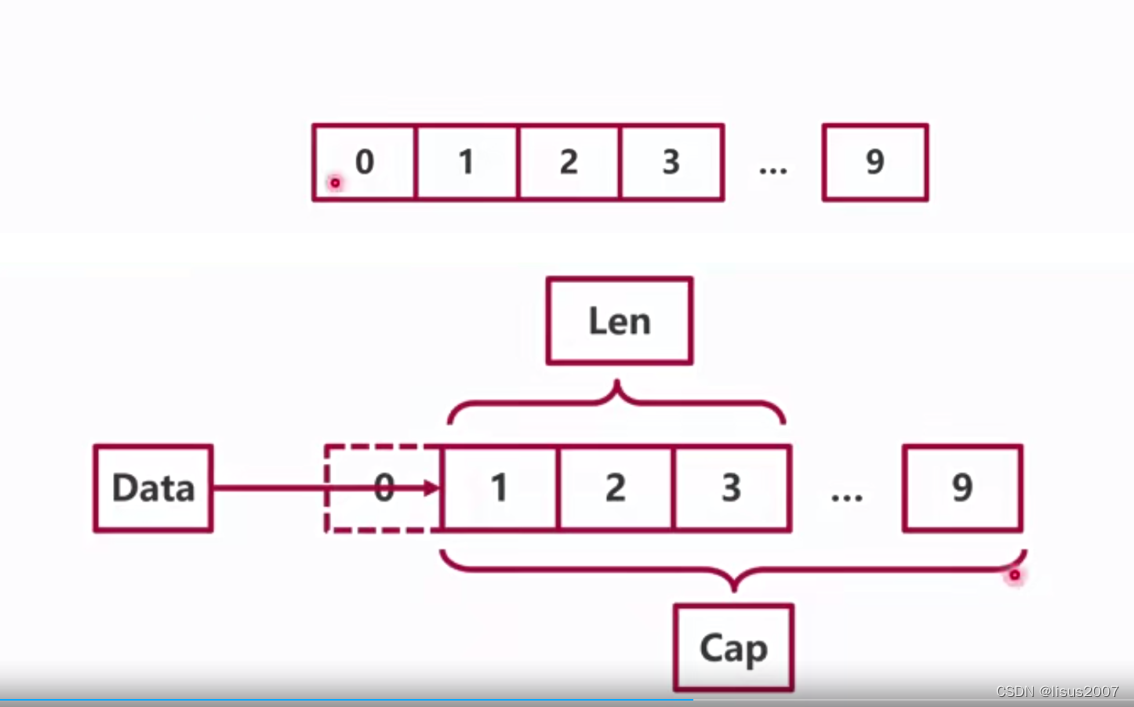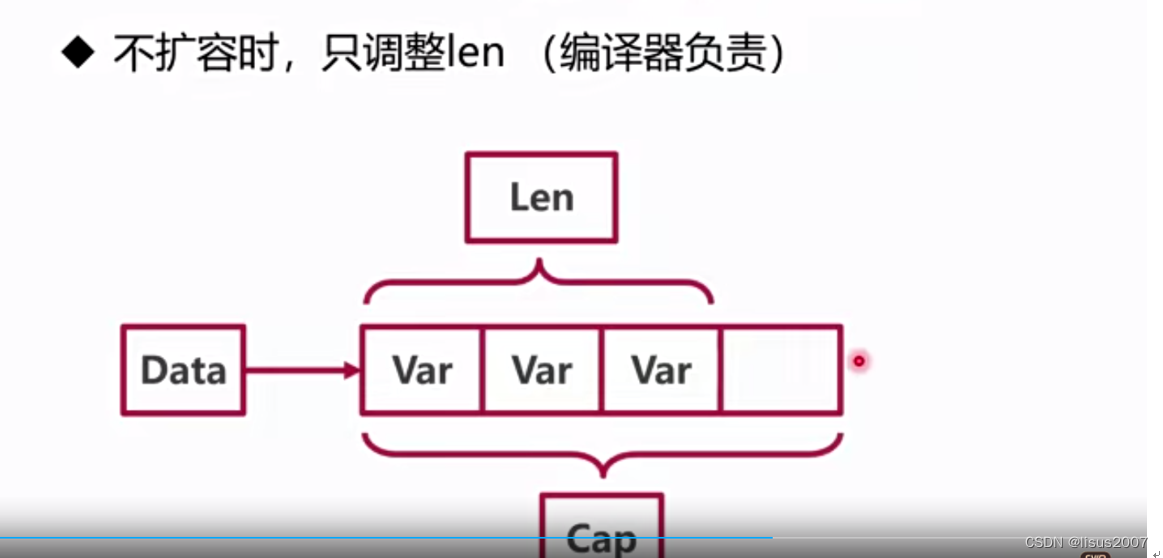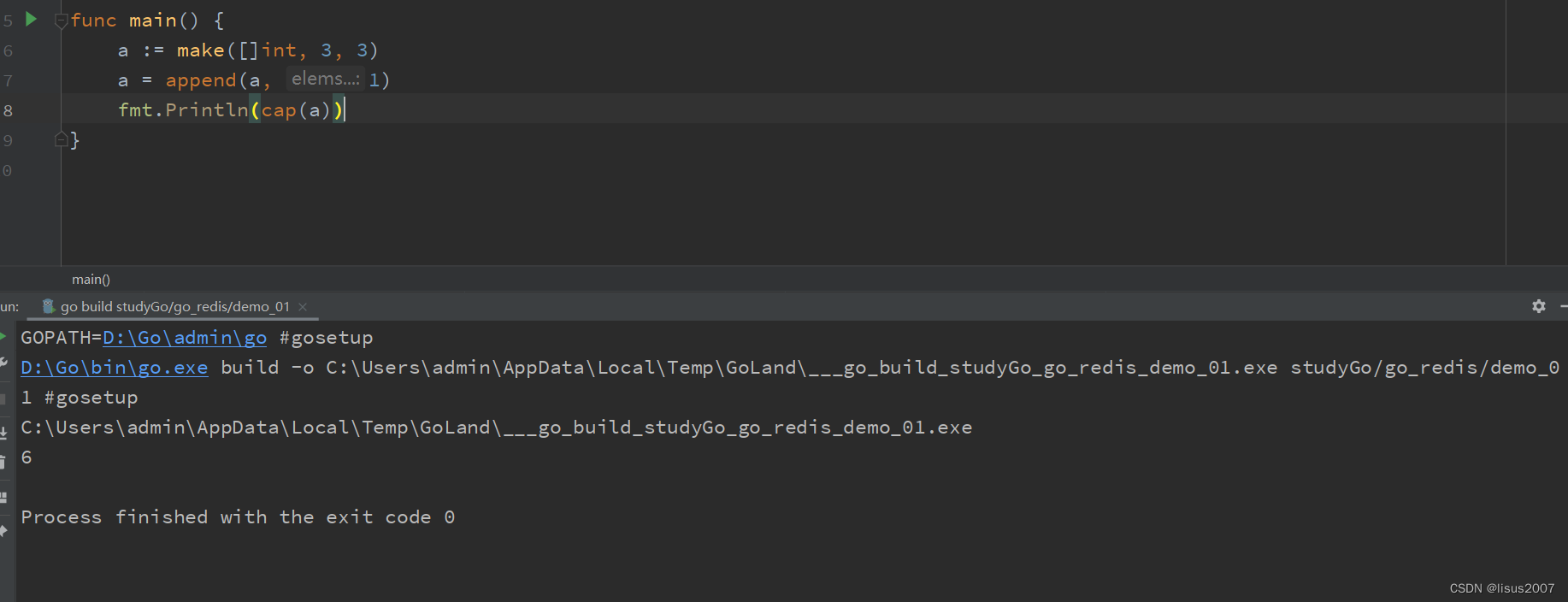切片的底层其实也是一个结构体,结构体定义如下
 切片的结构体由3部分构成,Pointer 是指向一个数组的指针,len 代表当前切片的长度,cap 是当前切片的容量。cap 总是大于等于 len 的。
切片的结构体由3部分构成,Pointer 是指向一个数组的指针,len 代表当前切片的长度,cap 是当前切片的容量。cap 总是大于等于 len 的。
切片的本质是对数组的引用
切片的创建

1,根据数组创建
arr[0:3] or slice[0:3]
2,字面量:编译时插和创建
当使用形如[]int{1,2,3}的字面量创建新的切片时,会创建一个array数组([3]int{1,2,3})存储于静态区中,并在堆区创建一个新的切片,在程序启动时将静态区的数据复制到堆区,这样可以加快切片的初始化过程
3.make:运行时创建数组

切片的扩容
切片的扩容分为两种
一种是不扩容时,只调整len,编译器负责
切片使用append函数添加元素,但不是使用了append函数就需要进行扩容,如下代码向长度为3,容量为4的切片a中添加元素后不需要。
 另一种
另一种

例如:切片增加元素后长度超过了现有容量,例如b一开始的长度和容量
都为3,但使用append函数后,其容量变为了6。
 append函数在运行时调用了runtime/slice.go文件下的growslice函数
append函数在运行时调用了runtime/slice.go文件下的growslice函数
unc growslice(et *_type, old slice, cap int) slice {
if raceenabled {
callerpc := getcallerpc()
racereadrangepc(old.array, uintptr(old.len*int(et.size)), callerpc, abi.FuncPCABIInternal(growslice))
}
if msanenabled {
msanread(old.array, uintptr(old.len*int(et.size)))
}
if asanenabled {
asanread(old.array, uintptr(old.len*int(et.size)))
}
if cap < old.cap {
panic(errorString("growslice: cap out of range"))
}
if et.size == 0 {
// append should not create a slice with nil pointer but non-zero len.
// We assume that append doesn't need to preserve old.array in this case.
return slice{unsafe.Pointer(&zerobase), old.len, cap}
}
newcap := old.cap
doublecap := newcap + newcap
if cap > doublecap {
newcap = cap
} else {
const threshold = 256
if old.cap < threshold {
newcap = doublecap
} else {
// Check 0 < newcap to detect overflow
// and prevent an infinite loop.
for 0 < newcap && newcap < cap {
// Transition from growing 2x for small slices
// to growing 1.25x for large slices. This formula
// gives a smooth-ish transition between the two.
newcap += (newcap + 3*threshold) / 4
}
// Set newcap to the requested cap when
// the newcap calculation overflowed.
if newcap <= 0 {
newcap = cap
}
}
}
var overflow bool
var lenmem, newlenmem, capmem uintptr
// Specialize for common values of et.size.
// For 1 we don't need any division/multiplication.
// For goarch.PtrSize, compiler will optimize division/multiplication into a shift by a constant.
// For powers of 2, use a variable shift.
switch {
case et.size == 1:
lenmem = uintptr(old.len)
newlenmem = uintptr(cap)
capmem = roundupsize(uintptr(newcap))
overflow = uintptr(newcap) > maxAlloc
newcap = int(capmem)
case et.size == goarch.PtrSize:
lenmem = uintptr(old.len) * goarch.PtrSize
newlenmem = uintptr(cap) * goarch.PtrSize
capmem = roundupsize(uintptr(newcap) * goarch.PtrSize)
overflow = uintptr(newcap) > maxAlloc/goarch.PtrSize
newcap = int(capmem / goarch.PtrSize)
case isPowerOfTwo(et.size):
var shift uintptr
if goarch.PtrSize == 8 {
// Mask shift for better code generation.
shift = uintptr(sys.Ctz64(uint64(et.size))) & 63
} else {
shift = uintptr(sys.Ctz32(uint32(et.size))) & 31
}
lenmem = uintptr(old.len) << shift
newlenmem = uintptr(cap) << shift
capmem = roundupsize(uintptr(newcap) << shift)
overflow = uintptr(newcap) > (maxAlloc >> shift)
newcap = int(capmem >> shift)
default:
lenmem = uintptr(old.len) * et.size
newlenmem = uintptr(cap) * et.size
capmem, overflow = math.MulUintptr(et.size, uintptr(newcap))
capmem = roundupsize(capmem)
newcap = int(capmem / et.size)
}
// The check of overflow in addition to capmem > maxAlloc is needed
// to prevent an overflow which can be used to trigger a segfault
// on 32bit architectures with this example program:
//
// type T [1<<27 + 1]int64
//
// var d T
// var s []T
//
// func main() {
// s = append(s, d, d, d, d)
// print(len(s), "\n")
// }
if overflow || capmem > maxAlloc {
panic(errorString("growslice: cap out of range"))
}
var p unsafe.Pointer
if et.ptrdata == 0 {
p = mallocgc(capmem, nil, false)
// The append() that calls growslice is going to overwrite from old.len to cap (which will be the new length).
// Only clear the part that will not be overwritten.
memclrNoHeapPointers(add(p, newlenmem), capmem-newlenmem)
} else {
// Note: can't use rawmem (which avoids zeroing of memory), because then GC can scan uninitialized memory.
p = mallocgc(capmem, et, true)
if lenmem > 0 && writeBarrier.enabled {
// Only shade the pointers in old.array since we know the destination slice p
// only contains nil pointers because it has been cleared during alloc.
bulkBarrierPreWriteSrcOnly(uintptr(p), uintptr(old.array), lenmem-et.size+et.ptrdata)
}
}
memmove(p, old.array, lenmem)
return slice{p, old.len, newcap}
}
Go语言中切片扩容的策略为:
◎ 如果新申请容量(cap)大于2倍的旧容量(old.cap),则最终容量(newcap)是新申请的容量(cap)。
◎ 如果旧切片的长度小于256,则最终容量是旧容量的2倍,即newcap=doublecap。
◎ 如果旧切片长度大于或等于256,则最终容量从旧容量开始循环增加原来的1/4,即newcap=old.cap,for {newcap+=newcap/4},直到最终容量大于或等于新申请的容量为止,即newcap ≥ cap。
◎ 如果最终容量计算值溢出,即超过了int的最大范围,则最终容量就是新申请容量。
注:切片扩容时,并发不安全,注意切片并发要加锁






















 1737
1737











 被折叠的 条评论
为什么被折叠?
被折叠的 条评论
为什么被折叠?








